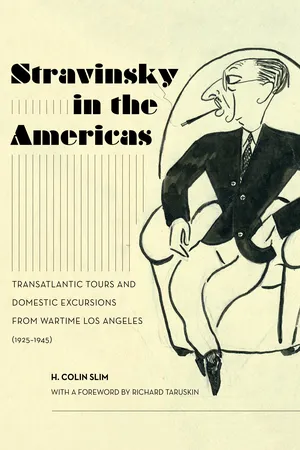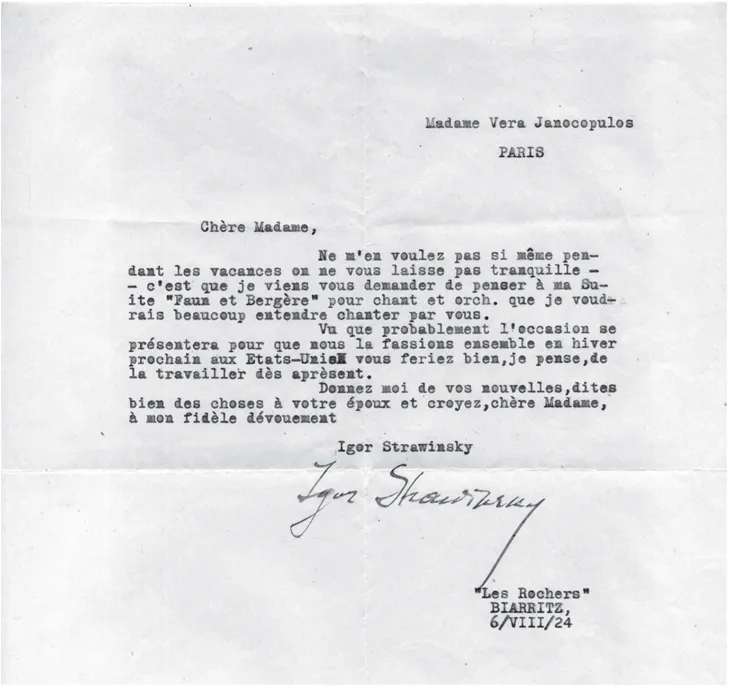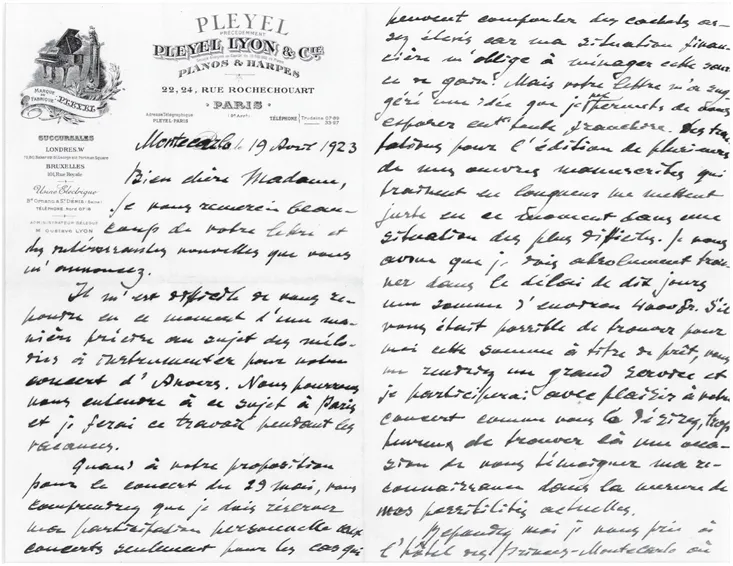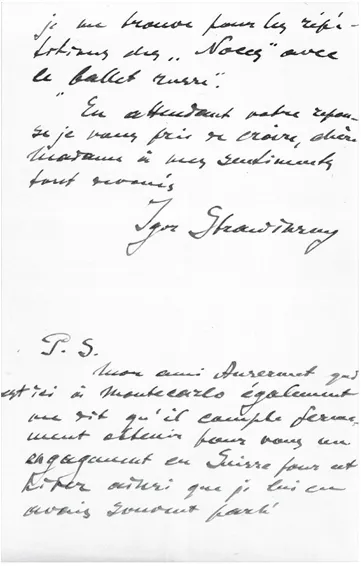
eBook - ePub
Stravinsky in the Americas
Transatlantic Tours and Domestic Excursions from Wartime Los Angeles (1925-1945)
- 488 pages
- English
- ePUB (mobile friendly)
- Available on iOS & Android
eBook - ePub
Stravinsky in the Americas
Transatlantic Tours and Domestic Excursions from Wartime Los Angeles (1925-1945)
About this book
Stravinsky in the Americas explores the “pre-Craft” period of Igor Stravinsky’s life, from when he first landed on American shores in 1925 to the end of World War II in 1945. Through a rich archival trove of ephemera, correspondence, photographs, and other documents, eminent musicologist H. Colin Slim examines the twenty-year period that began with Stravinsky as a radical European art-music composer and ended with him as a popular figure in American culture. This collection traces Stravinsky’s rise to fame—catapulted in large part by his collaborations with Hollywood and Disney and marked by his extra-marital affairs, his grappling with feelings of anti-Semitism, and his encounters with contemporary musicians as the music industry was emerging and taking shape in midcentury America. Slim’s lively narrative records the composer’s larger-than-life persona through a close look at his transatlantic tours and domestic excursions, where Stravinsky’s personal and professional life collided in often-dramatic ways.
Frequently asked questions
Yes, you can cancel anytime from the Subscription tab in your account settings on the Perlego website. Your subscription will stay active until the end of your current billing period. Learn how to cancel your subscription.
No, books cannot be downloaded as external files, such as PDFs, for use outside of Perlego. However, you can download books within the Perlego app for offline reading on mobile or tablet. Learn more here.
Perlego offers two plans: Essential and Complete
- Essential is ideal for learners and professionals who enjoy exploring a wide range of subjects. Access the Essential Library with 800,000+ trusted titles and best-sellers across business, personal growth, and the humanities. Includes unlimited reading time and Standard Read Aloud voice.
- Complete: Perfect for advanced learners and researchers needing full, unrestricted access. Unlock 1.4M+ books across hundreds of subjects, including academic and specialized titles. The Complete Plan also includes advanced features like Premium Read Aloud and Research Assistant.
We are an online textbook subscription service, where you can get access to an entire online library for less than the price of a single book per month. With over 1 million books across 1000+ topics, we’ve got you covered! Learn more here.
Look out for the read-aloud symbol on your next book to see if you can listen to it. The read-aloud tool reads text aloud for you, highlighting the text as it is being read. You can pause it, speed it up and slow it down. Learn more here.
Yes! You can use the Perlego app on both iOS or Android devices to read anytime, anywhere — even offline. Perfect for commutes or when you’re on the go.
Please note we cannot support devices running on iOS 13 and Android 7 or earlier. Learn more about using the app.
Please note we cannot support devices running on iOS 13 and Android 7 or earlier. Learn more about using the app.
Yes, you can access Stravinsky in the Americas by H. Colin Slim in PDF and/or ePUB format, as well as other popular books in Media & Performing Arts & North American History. We have over one million books available in our catalogue for you to explore.
Information
PART I
FIVE TRANSATLANTIC TOURS
(1925–1940)
1
TOUR I (1925)
CONCERT APPEARANCES
8–9 January: New York Philharmonic
15 January: New York charity, Vincent Astor Ballroom
23–24 January: Boston Symphony, and Piano Concerto soloist with Koussevitzky
25 January: New York, Aeolian Hall (chamber music) with Greta Torpadie
30–31 January: Philadelphia Orchestra
5–6 February: New York Philharmonic, and Piano Concerto soloist with Mengelberg
12–14 February: Cleveland Orchestra (half-concert with Sokoloff)
15 February: Philadelphia Orchestra, and Piano Concerto soloist with Reiner
20–21 February: Chicago Symphony (half-concert with Stock)
24 February [?]: Chicago Arts Club with Greta Torpadie
3 March: Detroit Symphony, and Piano Concerto soloist (half-concert with Kolar)
6–7 March: Cincinnati Orchestra, and Piano Concerto soloist with Reiner
Stravinsky’s initial voyage to the New World was preceded by several failed attempts. In 1916, at Lausanne, he tried to attach himself to Diaghilev’s and Nijinsky’s first US tour of the Ballet Russes but was foiled by Romola Nijinsky’s revision of her husband’s cable to its sponsor, the Metropolitan Opera.1 In 1919, while in New York, Nicolas Struve (director of Koussevitzky’s music publishing firm) tried to arrange a Stravinsky tour of the United States.2 When, in 1922, Stravinsky again contemplated a concert tour of the States, his letter from Biarritz on 4 February to Diaghilev seeks advice about whether he should write to America immediately or wait, because he must make up his mind quickly.3 A further stimulus was surely a letter mailed from Cincinnati by his longtime close friend, composer-pianist-conductor Alfredo Casella: “a me amico carissimo,”4 who wrote on 6 April 1923 of his own very successful second American tour, and even of his reengagement for “five similar tours.”5
The first of Stravinsky’s five transatlantic departures from France to the United States occurred in 1925, the next one in 1935; in 1936 he sailed with his pianist son to Brazil, Argentina, and Montevideo; in 1937 to the United States and Canada; and in 1939–40 to the United States, plus a train trip to Mexico. Reconstructing his travels has shed light on many aspects of his life.
“Igor’s cabin is the best one, in the exact center, and with all conveniences. A piano has been installed.”6 On board ship for his initial transatlantic voyage in 1925, Igor Fyodorovich Stravinsky traveled, as always, in high style. Arriving in New York early that January for a two-and-a half-month tour of the United States, Stravinsky might well have reflected on the women he left behind in Paris. On the verge of this, his first transatlantic crossing, he was involved with four women living in the French capital: his long-widowed mother, Anna; his sickly wife, Catherine, mother of his four children; and two women named Vera. He was probably involved with one Vera only musically but with the other certainly amorously. He had invited Vera (Janacopoulos), a well-known Brazilian singer from whom he hoped to obtain financial support, to accompany him on the tour (fig. 1.1), but she had demurred. The other Vera (Soudeikina), a Russian émigré like himself, was his mistress whom he supported financially. He did not invite her at that time, although he tried doing so later for a projected 1932 tour. Midway through his last overseas tour, she finally voyaged to the States to join him, and became his second wife in March 1940.

FIGURE 1.1
Stravinsky to “Madame Vera Janocopulos[-Staal],” 1924. UBC Stravinsky Collection, no. 27.
Stravinsky’s pretour correspondence with Vera, the singer, allows some notion of repertoire he planned for this initial transatlantic venture. Writing from Biarritz on 6 August 1924, he had asked the beautiful soprano Janacopoulos, then dwelling in Paris with her lawyer-husband, Alexey Fyodorovich Staal, to learn his 1906 orchestral-song cycle, Faun and Shepherdess.7 During his first concert tour to the United States, he hoped that he and she would perform it together.8 He had previously recommended it to her in 1923.9 Performed only a few times since its 1907 premiere in St. Petersburg,10 Faun was Stravinsky’s first published work and his first to be reviewed abroad. Initially, his interest in Janacopoulos had perhaps been kindled by Sergey Prokofiev. In December 1919, she had given the US premiere of Stravinsky’s Pribaoutki (1914) in New York. After attending both rehearsal and concert, Prokofiev wrote to Stravinsky, approving of the work and, equally, her performance.11
Was Stravinsky—married and with four children—simultaneously juggling one or even two married Vera’s? Since 1921 he had been carrying on with Vera de Bosset-Lury-Shilling-Soudeikina.12 She had never married Sergey Yuryevich Soudeikine, because he had never divorced his wife, Olga.13 Stravinsky married Vera de Bosset in March 1940 in the United States, a year after the death of his first wife. This marriage was illegal if Stravinsky perjured himself before a judge in respect to Vera’s nonmarriage to and nondivorce from Soudeikine.14
One writer believes that Janacopulos had a love affair with Stravinsky. These allegations are not convincing. But even if so, was this before or after she married Staal?15 The precise date of the Janacopulos-Staal marriage is unclear. Prokofiev refers to her as “Mlle” in mid-February of 1919,16 but Stravinsky’s letters to her in 1923 and 1924 address her as “Madame,” as does a Paris critic ca. 1925.17 In contrast, Prokofiev, who knew Staal and Janacopulos very well from 1918 until a major quarrel in 1924, called them the “Stahls.” Although he dearly loved gossip, he never penned a word about any such affair with Stravinsky.18
On 19 April 1923, Stravinsky had written Janacopulos—“Bien chère Madame”—asking for a loan of four thousand francs (fig.1.2), with the implied threat that unless she agreed, he would not accompany her at her Paris concert on 29 May. There she sang several works of his, including Tilimbom (1917) accompanied by the pianola (a mechanical piano). Since he did not play for her, although he attended her concert, it seems that she made him no loan and that she was not amorously involved with him.19 In any event, none of the four women crossed the Atlantic with him. It was just as well, because the voyage was extremely turbulent.

FIGURE 1.2a
Stravinsky to Vera Janacopoulos-Staal (front), 1923. UBC Stravinsky Collection, no. 23.

FIGURE 1.2b
Stravinsky to Vera Janacopoulos-Staal (back), 1923. UBC Stravinsky Collection, no. 23.
THE VOYAGE AND ITS AFTERMATH
Sailing in utter comfort on the SS Paris, though “twelve hours overdue . . . because of four days of rough weather . . . through blinding snow-storms,”20 Stravinsky arrived in New York on 4 January 1925. He traveled with Alexis Mikhailovich Sabline, his valet, secretary, and English translator.21 The very day of Stravinsky’s arrival, the Sunday music section of the New York World welcomed him with a column, “Stravinsky Debut with Philharmonic.” It also ran an illegibly signed drawing, counterfeiting a natty 1924 frontal photograph taken by the Studio Lipnitzki in Paris, that portrayed him with a dangling monocle, holding a cigarette in his left hand.22
In the words of a female observer on the Manhattan dock, it was a “flamboyant figure in black and orange who had walked down the gang plank.”23 The same reporter described his dapper attire at a press conference the next day: “Gold chain bracelets flanked a wrist watch. Rings with vari-colored stones covered his hands. With black patent-leather dancing pumps he wore grey bags, a striped shirt, a black tie with a pearl scarf-pin and a rose and taupe sweater.” She noted his talking
volubly and with precise phrasing and clever plays on words, now in French, ...
Table of contents
- Imprint
- Subvention
- Title
- Copyright
- Dedication
- Abbreviated Contents
- Contents
- List of Illustrations
- Foreword by Richard Taruskin
- Preface
- Acknowledgments
- Introduction
- Part I: Five Transatlantic Tours (1925–1940)
- Part II: Domestic Excursions From Wartime Los Angeles (1940–1946)
- Appendix: Stravinsky and “Neoclassicism”
- Notes
- Bibliography
- Index